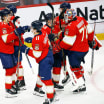VANCOUVER -- Andrei Vasilevskiy has an interesting theory on the ongoing decline in NHL save percentage, and how it’s made the challenge for the Tampa Bay Lightning top goalie and his puck-stopping peers more of a mental battle.
Asked this week about League wide save percentage being at .901, which would match the lowest mark in 19 seasons if it stays there, Vasilevskiy’s first response was not about how much younger and better the shooters are, or how much more dynamic the offensive chances they create have become.
Vasilevskiy did reference each factor, but the first thing the 2019 Vezina Trophy winner pointed to was how much fewer easy shots goalies face now.
“I feel like guys don't waste shots anymore,” Vasilevskiy told NHL.com. “You know, back when I came into the League (in 2014-15), it used to be 30 or 35-plus shots each game. It was almost every night, you felt good about your game, you were into it all the time. Nowadays, guys don't waste shots. It's all about the quality. They're all looking for that perfect play, perfect pass, perfect shot.”
Save percentage has declined since peaking in 2014-15 and 2015-16 at .915, reaching an 18-year low at .903 last season. That’s the lowest it’s been since a .901 in 2005-06, which came after the cancelled 2004-05 season led to smaller goalie equipment and new rules to reduce defensive interference, and the ongoing drop could soon see it below .900 since 1995-96.
While most of the attention on the decline in save percentage has focused on an influx of young shooters who have followed the well-established goalie model of working with position-specific skills coaches in the offseason, the way those players are using those increasingly dynamic abilities has played a role in making goalies’ lives more difficult. Players and teams use analytics to determine what types of scoring chances are most likely to succeed, and with that increased understanding of how best to score, more of the shots goalies face seem to be more dangerous, with an emphasis on lateral plays across the middle of the ice that force goalies to rotate completely from one side to the other.
With the increased recognition of what types of plays lead to goals has also come more awareness of what shot don’t, and a decrease in those easy shots.
“In my opinion it's all those young players, they're super-skilled and they know if you shoot at net with no traffic the goalie will catch it and then what?” Vasilevskiy said. “Whistle, the play is dead, and nobody will pat you in the back for that.”
Entering Thursday, shots per game were down in the NHL this season to 57.4 from 60.6 last season and a five-season high of 63.3 in 2021-22. As for how much of that overall drop is a decline in those easier shots Vasilevskiy talked about, in the four seasons that NHL EDGE data has been tracking long-range shots, which has a .970 League average save percentage, the per-game average number of long-range shots has dropped from 14.9 in 2021-22 to 12.81 this season (entering play Thursday).
Of course, not all shots from further out are the same. Part of the increased focus on what type of shots lead to goals has been an increase in targeted traffic in front of the goalie. And again, back to Vasilevskiy’s point, with that knowledge has come a decrease in the number of unscreened shots from the perimeter.
Former NHL goalie Steve Valiquette, who founded Clear Sight Analytics and works as a television analyst for New York Rangers broadcasts on MSG, said the number of unscreened shots -- he calls them clear-sighted shots because the goalie can see the release -- from long range is down 27.9 percent the past six seasons, and the amount of those shots from outside the slot has dropped 20.8 percent.
Some teams view those types of shots as a turnover, trading clear possession of the puck for the chance to win it back on the ensuing face-off.
“Vasilevskiy is spot on,” said John Healy, who is the chief operating officer at Clear Sight Analytics and also works one-on-one with NHL forwards and defensemen on how best to create offense. “We’ve stopped taking these clear-sighted shots.”
If goalies face fewer of the shots they stop 97 percent of the time, and more shots that go in at a 20-40 percent rate, no wonder save percentage is down.
“That's definitely a very interesting outlook and I have to agree with it,” St. Louis Blues goalie Jordan Binnington said of Vasilevskiy’s theory. “It's just no wasted shots. That’s the new age mindset. A lot of our team meetings are just about how to score, finding ways to score, rather than getting just pucks to the net.”
Beyond the statistical decline, that mindset creates more of a mental challenge for goalies, many of whom prefer games when they are busier.
“You stay in the blue paint waiting for something to happen and you have lots of energy and thoughts, and that's not a perfect scenario,” said Vasilevskiy, who skates crease-movement patterns during TV timeouts and handles the puck more to stay engaged. “When you don't have shots, you are thinking about how you’re going to play instead of playing the game but when you have a lot of shots, you don't think, you just play, so obviously that’s much easier.”
And seeing fewer of the easier shots is not.


















